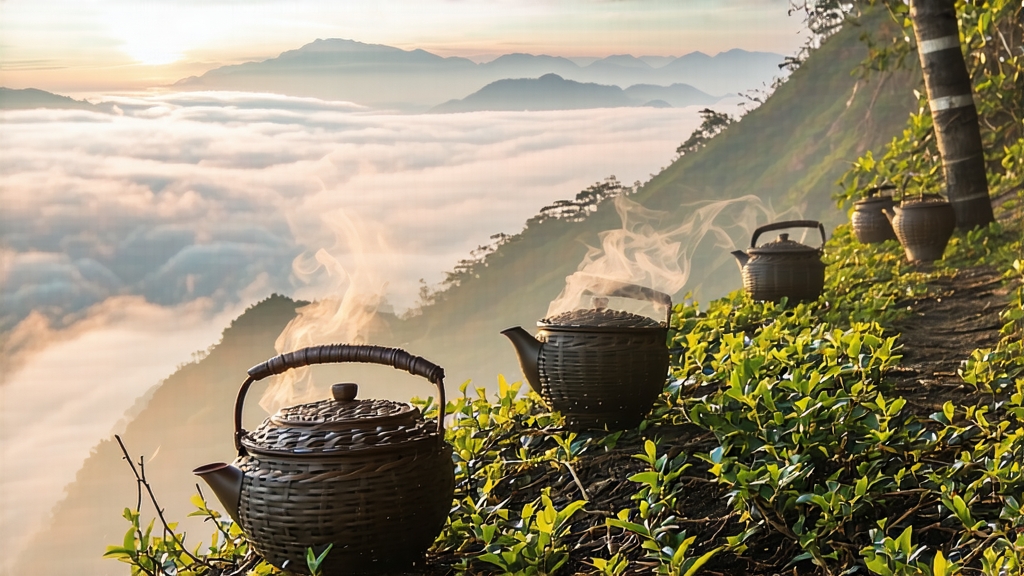
Long before English breakfast tables knew the malty kiss of any “black” tea, caravans loaded an unusual leaf from the Wuyi massif of northern Fujian and followed the Nine-Bend River down to the port of Xiamen. The year was 1646, the Qing dynasty had just begun, and the Dutch were frantic for anything that could withstand a six-month sea voyage better than green tea. Local growers, so the story goes, hastened drying over fresh pine embers to meet the order; the accidental smoke became the signature of what the Fuzhou merchants labelled Lapsang Souchong—literally “small-leaf variety from the original high mountain.” Within two decades it reached Amsterdam, London, and the court of Versailles, birthing Europe’s very first concept of “black” tea and, by extension, the entire culture of afternoon tea.
True Lapsang Souchong is still produced only inside the 60-km core of the Wuyi UNESCO geopark, where a subtropical monsoon cloaks granite cliffs in 80 % humidity and a diurnal swing of 15 °C. Two cultivars dominate: the hardy Xiao Ye Zhong (“small leaf”) that gives the tea its name, and the more fragrant Wuyi Qizhong clonal selection developed in the 1960s. Between them growers can craft four distinct commercial styles. Traditional Smoke-dried Lapsang is withered over pine fires, rolled, oxidised 90 %, then smoked again in bamboo baskets suspended above a pinewood hearth until the leaf hits 3 % moisture. Modern “unsmoked” or “fruit-style” Lapsang skips the final firing, relying instead on charcoal baking to showcase cocoa-and-honey notes prized in Beijing and Shanghai. A third experimental “light smoke” version receives only a ten-minute finish over embers, marrying sweet potato aroma with a whisper of resin. Finally, the rare “wild” pick, harvested from feral bushes above 1 200 m, is withered naturally in mountain caves and smoked for three consecutive nights, yielding a whisky-coloured liquor that perfumers compare to lapsang-infused single malt.
Craft begins in the cool pre-dawn of late April. Pickers take only the standard “two leaves and a bud” stretch, but insist the third downstream leaf remain on the stem to keep sap flowing—an old trick that deepens sweetness. The leaves are laid 3 cm deep on bamboo trays set over a shallow pit of smouldering long-leaf pine and local Masson pine; the fire must never flame, only sigh. For eight hours the tea master flips the leaf every 20 minutes, coaxing moisture down to 60 % while resins penetrate the cell walls. Oxidation follows in cedar-lined troughs kept at 26 °C and 85 % RH; here the leaf turns from jade to copper as catechins convert to theaflavins. Rolling is still done by foot—an apprentice grips an overhead bamboo rail and rocks across a 10 kg heap for 45 minutes, breaking tissue without pulverising it. After a brief rest the leaf is fired in 70 °C charcoal ovens, then transferred to the smoking loft: four tiers of bamboo baskets, each loaded with 5 kg of tea, sealed beneath a tiled roof that holds the pine smoke like a cathedral holds incense. A master called the “fire keeper” stokes the hearth every hour through the night; by dawn the leaf glistens with essential oils, and the scent has moved from campfire to pipe tobacco to dried longan.
To brew Lapsang Souchong for western palates, abandon the teaspoon clichés and think like a whisky blender: ratio, water chemistry, and time are everything. Use 4 g of leaf for 120 ml—about the capacity of a small gaiwan—and water just off a rolling boil, 98 °C. Rinse for two seconds to wake the leaf, discard, then infuse 8 s, 12 s, 18 s, 30 s, and 60 s on subsequent steeps. The first cup should smell of pine sap and burnt sugar; the second introduces a surprising note of dried lychee; by the third you may catch the cooling camphor finish that Wuyi locals call “yan yun”—rock rhyme. If you prefer a western mug, dose 2 g per 250 ml, infuse 3 minutes, and add a splash of cold milk: the